
Boyoma Falls, formerly known as Stanley Falls, consists of seven cataracts, each no more than 5 m (16 ft) high, extending over more than 100 km (62 mi) along a curve of the Lualaba River between the river port towns of Ubundu and Kisangani/Boyoma in the Orientale Province of the Democratic Republic of the Congo.

The Aruwimi River is a tributary of the Congo River, located to the north and east of the Congo.
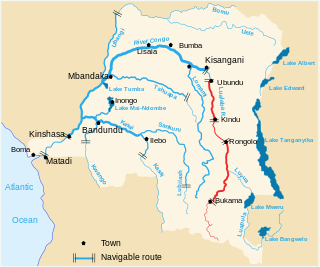
The Lualaba River flows entirely within the eastern Democratic Republic of the Congo. It is the greatest river source (headstream) of the Congo River by volume of water. The Lualaba is 1,800 kilometres (1,100 mi) long. Its headwaters are in the country's far southeastern corner near Musofi and Lubumbashi in Katanga Province, next to Zambia. The Chambeshi River is the longest river source (headstream) of the Congo.

The Pool Malebo, formerly Stanley Pool, also known as Lake Nkunda by local indigenous people in pre-colonial times, is a lake-like widening in the lower reaches of the Congo River. The former name Stanley Pool was named after early European explorer and journalist Henry Morton Stanley.
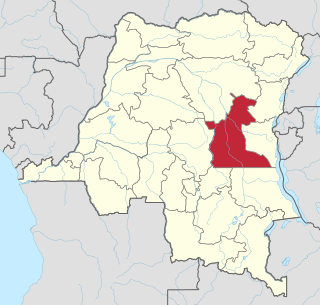
Maniema is one of 26 provinces of the Democratic Republic of the Congo. Its capital is Kindu.
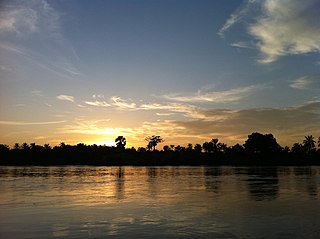
The Kasai River is a tributary of the Congo River, located in Central Africa. The river begins in central Angola and flows to the east until it reaches the border between Angola and the Democratic Republic of the Congo (DRC), where it turns north and serves as the border until it flows into the DRC. From Ilebo, between the confluences with Lulua river and Sankuru river, the Kasai river turns to a westerly direction. The lower stretch of the river from the confluence with Fimi river, is known as the Kwa(h) River, before it joins the Congo at Kwamouth northeast of Kinshasa. The Kasai basin consists mainly of equatorial rainforest areas, which provide an agricultural land in a region noted for its infertile, sandy soil. It is a tributary of Congo river and diamonds are found in this river. Around 60% of diamonds in Belgium go from Kasai river for cutting and shaping.

Tippu Tip, or Tippu Tib, real name Hamad bin Muhammad bin Juma bin Rajab el Murjebi, was a Arab–Zanzibari slave trader, ivory trader, explorer, plantation owner and governor. He worked for a succession of the sultans of Zanzibar. Tippu Tip traded in slaves for Zanzibar's clove plantations. As part of the large and lucrative ivory trade, he led many trading expeditions into Central Africa by constructing profitable trading posts that reached deep into the region. He bought the ivory from local suppliers and resold it for a profit at coastal ports.

Livingstone Falls — named for the explorer David Livingstone — are a succession of enormous rapids on the lower course of the Congo River in west equatorial Africa, downstream from Malebo Pool in the Democratic Republic of the Congo.
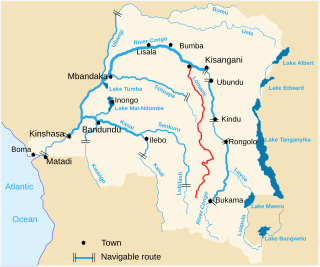
The Lomami River is a major tributary of the Congo River in the Democratic Republic of the Congo. The river is approximately 1,280 kilometres (800 mi) long. It flows north, west of and parallel to the upper Congo.
Colonization of the Congo refers to the European colonization of the Congo region of tropical Africa. It was the last part of the continent to be colonized. By the end of the 19th century, the Congo Basin had been carved up by European colonial powers, into the Congo free state, the French Congo and the Portuguese Congo.

Boma is a port town on the Congo River, some 100 km upstream from the Atlantic Ocean, in the Kongo Central province of the Democratic Republic of the Congo. It had an estimated population of 162,521 in 2012.

The Luama River is a tributary of the Lualaba River in the Democratic Republic of the Congo (DRC).
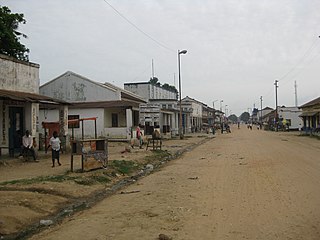
Kindu is a city in the Democratic Republic of Congo, the capital of Maniema province. It has a population of about 200,000 and is situated on the Lualaba River at an altitude of about 500 metres, and is about 400 km west of Bukavu.

Nyangwe is a town in Maniema, on the right bank of the Lualaba in the Democratic Republic of Congo. It was one of the main slave trading states in the region at the end of the 19th century.

Bolobo is a town on the Congo River in Plateaux District of Mai-Ndombe Province in the western part of the Democratic Republic of the Congo (DRC). It is the administrative center of the Bolobo Territory. As of 2009 it had an estimated population of 31,366.

The Congo Arab war took place in what is now the Democratic Republic of the Congo between the forces of Belgian King Leopold II's Congo Free State and various Zanzibari Arab slave traders led by Sefu bin Hamid, the son of Tippu Tip. Fighting occurred in the eastern Congo between 1892 and 1894. It was a proxy war, with most of the fighting being done by native Congolese, who aligned themselves with either side and sometimes switched sides. The causes of the war were mainly economic, since Leopold and the Arabs were contending to gain control of the wealth of the Congo. The war ended in January 1894 with a victory of Leopold's Force Publique. Initially King Leopold II collaborated with the Arabs but competition over the control of ivory and Leopold II's humanitarian pledges to the Berlin Conference to end slavery, turned his stance to confrontational. The war against the Swahili-Arab economic and political power was presented as a Christian anti-slavery crusade.

Lokandu is a community in Maniema Province of the Democratic Republic of the Congo, on the Lualaba River downstream from Kindu.
The Livingstone Inland Mission (LIM) was an evangelical missionary society that operated in what is now the Democratic Republic of the Congo between 1878 and 1884.

















